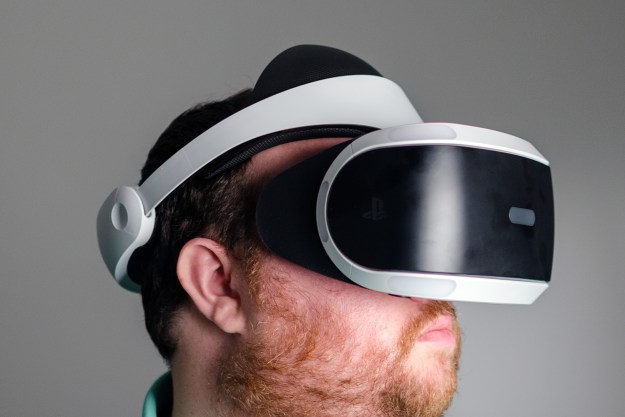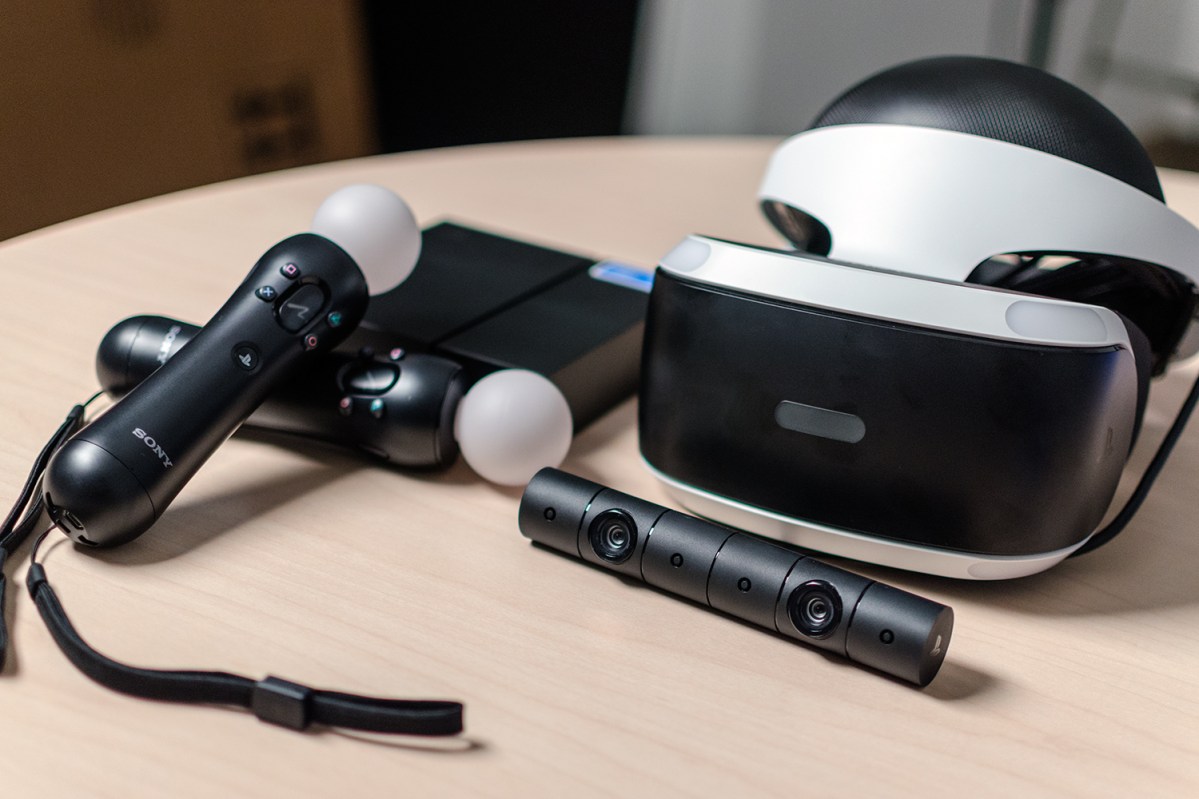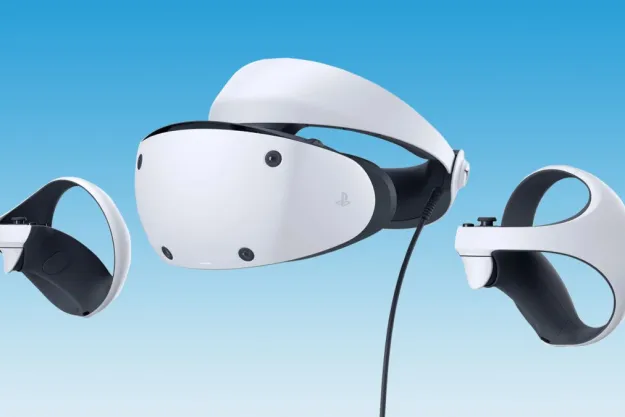
- Good game library at launch
- Great headset security
- Achieves that “full VR” sensation
- PlayStation Network filters out broken games
- More affordable than Rift or Vive
- Makes a mess
- Not as powerful as Rift or Vive
For most people, virtual reality is still an idea, not a tangible piece of technology. It’s been well over a year since the release of the Oculus Rift and HTC Vive, but the high cost of both the headsets and a PC with the giddyup to power them has kept the pair relatively niche. Sony’s headset, PlayStation VR, effectively cuts that barrier in half: A new PlayStation 4 and a headset bundle that includes some mandatory accessories is the first non-mobile VR option to cost less than $1,000. Plus, Sony has sold than 60 million consoles as of August, 2017, so there’s a much larger number of players with PS4 consoles than users with VR-capable PCs.
Is it worth it?
In a word, yes. While PSVR offers limited power and options compared to Rift and Vive, it is still a worthy “full VR” experience, offering the kind of virtual reality that can trick you into thinking you’re somewhere else. You can look over the edge of a cliff, dive at the bottom of the ocean, or even fly.
Out of the box
Setting up the PlayStation VR headset through a PlayStation 4, whether or not the console has already been connected, is relatively painless. The device comes with a standalone box, officially referred to as a “processor unit,” which serves as the hub for the PS4, the TV, and the headset. You must also connect the PlayStation Camera, which comes bundled with the hardware, and plugs into a dedicated port in the back of the console. There are clear instructions in the box to guide you, plus a couple intuitive guides built into the hardware itself.
There’s also a $450 bundle, which includes the headset, camera, the PlayStation VR Worlds game, and two PlayStation Move motion controllers. Most games are played using the DualShock 4 controller, but some games can use the Move controllers and others require it. In general, the VR experience is heightened when using motion controllers instead of a standard gamepad, so we recommend picking up the $450 option if you don’t have any spare Move controllers lying around.
PlayStation VR games have the potential to make you excited, uncomfortable, or even scared.
Once unpacked, you may notice that having “full VR,” at home makes a horrible mess out of whatever space you devote to it. While the PS4 console has a pleasant design that doesn’t necessarily stand out among a cable box and other set-top devices, the PSVR hardware is an expansive mess of cords and cables. You must plug HDMI and USB cables into PSVR’s standalone “processor box.” From there, another HDMI cable must go to the TV and two cable must plug into the PSVR. Plus, the processor box requires a discrete power source.
Plus you have to charge a DualShock 4 and (possibly) two Move controllers. This is not a new problem for players who have been using the Move for years, but with the PSVR using one of the USB slots, a charging station of some sort is essential for both storage and managing power. Sony provided us with an officially licensed stand made by Power A, which charged all three controllers and held the headset itself. While it reduced clutter, it’s also another big cumbersome item to put somewhere.
Putting it on
The PSVR headset itself feels well built. The headset itself is made of heavy plastic, with padded bands on the front and rear where the headset presses against your head. At 610 grams (just over 1.3 pounds), it has weight, but you’re unlikely to feel burdened by it as you play. The rubber sides of the headset and nose guard effectively block outside light when the headset is adjusted properly, though they also make the inside of the headset incredibly hot.
Putting on the headset can be a bit tricky. You must extend the back strap over their head, then tighten it around their cranium with a twisting dial. Then you can adjust the proximity of the lens to your face by pressing a button underneath the front of the headset. Finally, you can make final tweaks to the vertical angle using the same front button.
Oh, and at some point you should probably put on your headphones. While you can simply listen to audio coming out of the TV, you should plug some headphone into the jack on the PSVR’s power panel, a small row of buttons on the cable coming out of the device. The headset comes with a set of stereo earbuds, but we recommend using a game headset or other over-the-ear headphones to maximize the experience.
All of these steps make the headset fit well on your head and stay in place, even when you’re whipping your head around while playing. It also does a great job blocking all outside light, allowing you to focus solely on your game.
It’s also a bit of an ordeal. There’s a tutorial that walks you through the process that first time the headset is turned on, and it can be replayed from the PSVR settings menu, so you won’t ever be stuck not knowing how to wear it, but it is a lot of steps and you need to do all of them every time. If the headset doesn’t fit perfectly, games will appear blurry and text will be difficult to read: The added strain on your eyes can make games harder to understand and cause headaches.
The kind of VR you want
It should come as no surprise that the PlayStation VR headset does not have the technical capabilities of its full VR counterparts. The headset sports a pair of 960xRGBx1080 RGB displays — one for each eye — and runs off the PS4’s AMD Radeon GPU, which is far less powerful than the minimum required specs for a Vive- or Rift-compatible PC. It also has a 100-degree field of view, which is slightly smaller than the Rift and Vive.
Many games showed little to no signs of the dreaded “screen door effect.”
While it can’t compare to those two on a spec sheet, PlayStation VR nonetheless achieves that feeling of complete immersion that comes from a “full VR” device, as opposed to mobile-powered options like Google Cardboard. PlayStation VR games have the potential to make you excited, uncomfortable, or even scared. By surpassing that threshold, PlayStation VR automatically propels itself into a very small number of headsets that can deliver the kind of virtual reality fans have been waiting for. In its theater mode, which presents the action on a virtual “screen” in front players, you can also watch 3D Blu-ray video.
In general, the fidelity and quality of the PSVR experience varies wildly depending on what game you’re playing. Players who buy PSVR expecting to play picture-perfect adaptation of your favorite PlayStation franchises will be very disappointed. Games that attempt to create intricately detailed character models, such as Batman: Arkham VR, tend to suffer from the dreaded “screen door” effect, and appear very grainy.
On the other hand, many games work within the console’s limitations and showed little to no sign of pixelation. These games tend to be smaller in size and scope. That, too, works to their benefit, because they don’t tax your ability to process VR. While some games and demos suggest you will be able to adapt and play for increasingly long stretches of time, you should not expect to play any VR game as long as you play conventional video games.
The same goes for the headset’s ability to potentially induce nausea. After playing 10 games, plus a variety of a release-day-ready demos, it does not seem like the hardware itself makes you sick.
Some games, on the other hand, are less forgiving. Most games did not induce nausea on those of us who tested the device, but a couple games did make us feel queasy. They were first-person games that allowed us to strafe, or move sideways at full speed with no friction or impediment. This type of movement, which is not natural, seemed to have an almost universal negative effect on our stomachs.
Stay in your box! The camera can’t see you
There are other technical limitations as well. The PlayStation Camera has a very small and specific area where it can effectively track the movement of the PSVR headset and Move controllers. You can sit or stand, but if you lean too far forward or stretch your arms out too wide, the camera will lose track of you, often leading to a jarring disconnect between your body and the screen. Motion-centric games like Job Simulator: The 2050 Archives, which benefit from the HTC Vive’s room-scaling technology, can feel constrained and clunky without the ability to move around much.
The one benefit the PlayStation Camera seems to convey over the Vive and Rift set-ups is that it requires a slightly less square footage. Like all camera-and-sensor based devices, including VR headsets and the Xbox One’s Kinect body tracker, PSVR requires a large open play area. PSVR technically requires 6.2’ x 9.8’ feet (width x length) of free space, but since you are sitting and not moving around, you can shave off a few inches with minimal impact.
Your TV becomes a social screen
PlayStation VR’s most distinctive feature may its “social screen,” a mirrored version of what the player wearing the headset is seeing. While the Rift and Vive can output the same image to a PC monitor, the fact that many users will have their PS4, and thus PSVR, connected to television in a public space makes PSVR a better VR showpiece and group activity.
While the social screen does output at a lower resolution than the PS4 does under normal conditions, what the screen shows generally looks very similar to what’s shown in the headset. It’s only on the PlayStation 4 home screen that the device’s reduced output becomes clear.
PSVR is for gamers
It’s important to keep in mind that PlayStation VR is a peripheral for the PS4, not a platform. Some familiarity with the console and controller is expected. The Rift and Vive require a PC to operate, but both devices have dedicated menus, methods for control input, and storefronts. PlayStation VR, on the other hand, is completely integrated into the PlayStation Network, and most of its games use either the PS4’s DualShock 4 controller or previously released PlayStation Move motion controllers. There is no special PSVR menu, or even any distinction between VR and non-VR games on the screen.
If you want to try full VR in your home, PlayStation VR will do that for you for the best price.
This distinction may seem semantic — there’s a good chance that many people interested in PSVR already own a PS4. People who are not familiar with PlayStation — or video games in general — will likely have trouble navigating the system-level console menus and playing many games.
There is a certain amount of jank in even the most polished VR experiences in 2016, and PSVR is no exception, but the bar is clearly higher than on Oculus and the Steam (Vive) VR game stores. A fairly steady stream of games have been released since launch, including the shooter Farpoint, so you have plenty of options to choose from.
Warranty information
PlayStation VR includes a one-year limited liability warranty from the manufacturer. This does not include damage you do by dropping or damaging it.
Our Take
Even with everything it does to make virtual reality more accessible and affordable, PlayStation VR isn’t for everyone. It’s still several hundred dollars, requires a fair amount of set-up, and there are still only a handful of games that run smoothly, with no technical issues.
But if you haven’t used VR much, the PlayStation VR will blow you away. It will make you feel like you’re moving while you’re standing still, and turn your living room into far away worlds.
Our take
If you want to try full VR in your home, PlayStation VR will do that for you for the best price. You may not be able to walk around freely in virtual reality like you can on the HTC Vive, but that doesn’t make any less satisfying.
Is there a better alternative?
On a purely technical level, the HTC Vive remains the gold standard for hobby-grade virtual reality. With a higher resolution display and room-scale motion tracking, it can do things that PlayStation VR simply cannot. However, the HTC Vive costs roughly double what HTC Vive does. If you want to want to spend less than $1,000 dollars on VR setup (headset and PC/console), PSVR really is your only option.
In October, 2017, Sony announced it will release an updated PSVR headset with support for HDR pass-through and integrated stereo headphones. Sony has not set a North American release date for the new headset, and we haven’t tested it yet, but it may improve some of our issues with the hardware.
How long will it last?
There’s no way to know, really. This headset is the first of its kind and there are currently no plans for a next-generation model. The most important factor in determining the lifecycle of any video game platform is developer support. That support will be, at least in part, determined by hardware sales.
Should you buy it?
Yes. PlayStation VR has a slate of fun games that offer a new type of entertainment. Unless you’ve used an Oculus Rift or HTC Vive, you have not experienced what PlayStation VR has to offer, and you should. Virtual reality, generally speaking, will blow your mind.
If you do not own a PlayStation 4, the PlayStation 4 Pro does offer a slightly better experience, with better draw distance and particle effects in certain games, but it isn’t a drastic improvement.
Updated by Gabe Gurwin on 10-04-2017: Updated with information on updated model with HDR pass-through.
Editors' Recommendations
- Is Stardew Valley cross-platform?
- PS5 Pro: news, rumored release date, price, and specs
- The best skills to buy first in Another Crab’s Treasure
- Best video game deals: PlayStation 5, Xbox S and X, Nintendo Switch
- PlayStation 6: release date speculation, price, specs, and more









